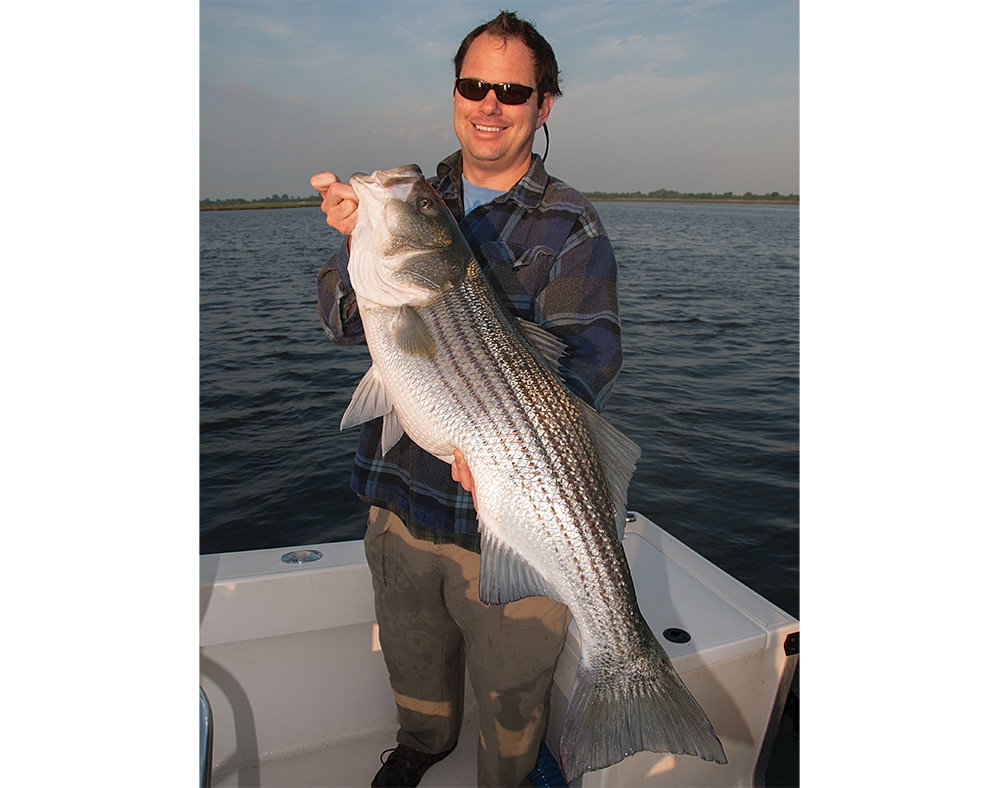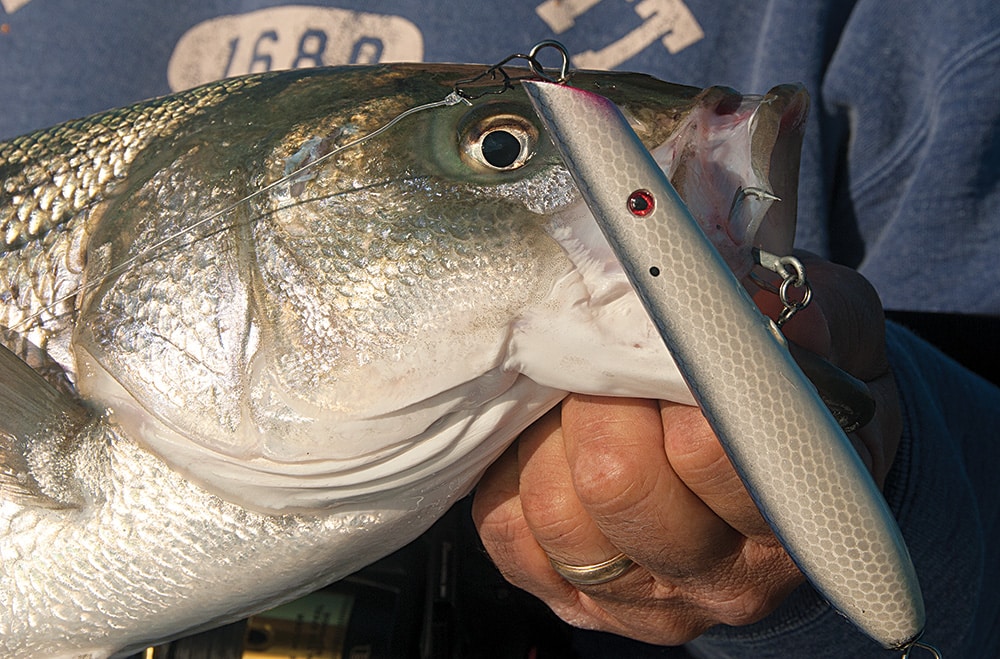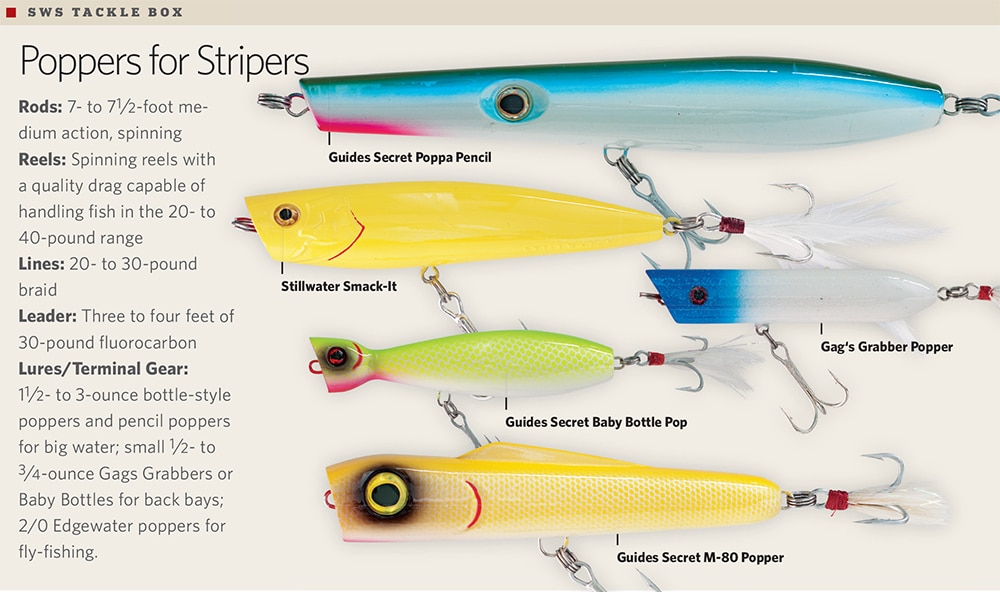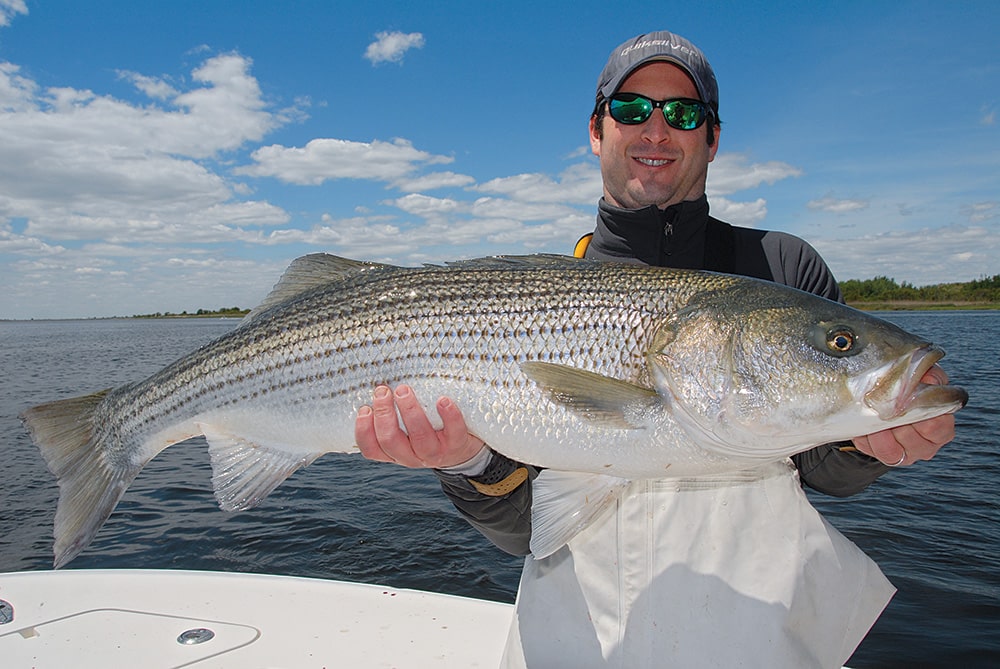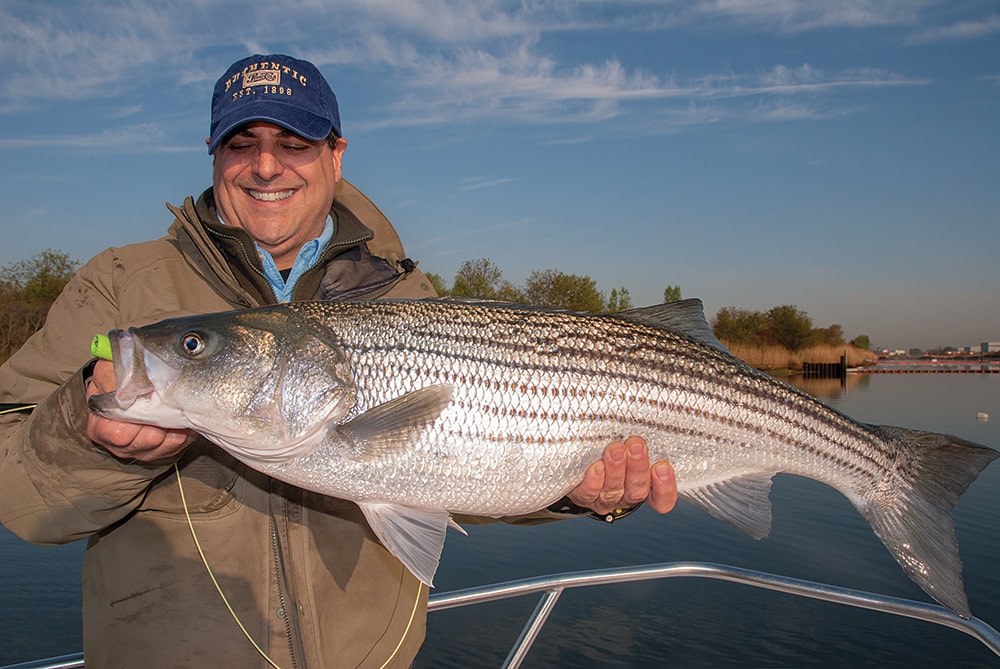
We’d been unsuccessfully plugging the rock outcropping for an hour when I noticed David rummaging through his tackle box, resurfacing with a popper. “That’ll just spook anything here,” I naively said. One cast, one pop and a swirl formed behind it, another pop and POW! A broad tail sent the plug skyward. One more twitch, and the plug disappeared under a boil and line screamed off the reel.
Poppers work magic on stripers, particularly on structure such as rocks, rip lines, and sod banks, and demonstrate the extraordinary aggressiveness of these animals. They’re sometimes effective when nothing else will draw interest. Nothing gets the heart pumping like a violent surface strike in what seemed like dead water. These explosions never fail to take my breath away.
Active or Reactive?
Why stripers eat poppers, particularly on structure, is a relevant question given they will often slam them when they are not visibly feeding, or when they are feeding on a bait that looks and acts nothing like a popper. Opinions vary, but many believe that it’s an instinctual, aggressive reaction. “It’s a territorial thing,” says Block Island guide Greg Snow. “It’s in their zone; they’re going to smack it.” This is likely true.
In those cases when stripers are feeding on small bait, or don’t appear to be feeding at all, I get more boils and tail slaps than actual strikes, as if they are trying to punish the popper rather than eat it. “A lot of the time, it aggravates them and they just blast it,” says Chesapeake guide Richie Gains.
Frank Crescitelli, New York guide and designer of an innovative line of poppers under the brand Guides Secret, believes poppers simply get the fish going. “They inspire action,” he says. “They might not be in feeding mode, but poppers get things going by ringing the dinner bell.”
Certainly poppers trigger a striper’s competitive nature. “In Block Island the water is clear, so we often see a dozen fish laying up,” says Snow. “They ignore a live bait, but when you throw a popper, it gets their attention. They get competitive.”
To Pop or Not to Pop
Sure, you’ll want to grab a popper any time you see surface action. But when no surface activity is apparent, I still give them a try, especially when working structure. Poppers often work in the most unlikely circumstances. Gains describes an excellent Chesapeake Bay Bridge Tunnel bite last winter: “The best pilings are in 50 feet of water; the stripers are 20 feet down, and they still come up to grab a popper.”
One of my favorite popper-fishing settings is the back-bay sod-bank scenario found in saltwater marshes from Maine to Virginia. The mud flats in front of sod banks hold small bait, such as grass shrimp, crabs and worms. When small-bait hatches go off, there are thousands of critters in the water. “Matching the hatch” can be useless when there is so much of the real thing. Poppers cause that aggressive reaction though, especially in shallow water. They’ll draw strikes when nothing else will.
Another good place to use poppers is along rocks, riprap, jetties and other hard, sloping structure. Stripers prowl these areas, staging on leeward rocks, waiting in ambush. New Jersey guide Gene Quigley does a lot of his popper fishing along central and northern Jersey Shore jetties. “Our jetties slope gradually underwater, and fish are right in those rocks,” he says. “They will smash something splashing around above them.”
Shallow water, particularly along drop-offs, is also good popper territory. Connecticut River guide Blain Anderson fishes poppers on the flats, focusing on the edges, turns and bends that river herring seem to hug. Likewise, Gains — who fishes the Susquehanna Flats in the spring — uses poppers on the edges of ditches and sloughs in the flats, which are also areas that river herring frequent. Rip lines created by current and depth changes are also a good bet. “Stripers stage just before or after the rip, and crash the bait as it washes over the shallows,” says Cape Cod guide Terry Nugent. Any shallow-breaking surf is a prime place to use poppers. During all the natural commotion in the surf zone, a popper works wonders getting noticed.
Popper Personality
What makes a good striper popper? “The more noise they make, the more attention they will garner,” says Crescitelli, adding that “rattles help.”
“The bigger the water, the larger and noisier the popper should be,” says Gains. That’s even more relevant when stripers are up in the white water. Good plugs for big water include the array of bottleneck poppers, as well as plugs like Guides Secret M-80s. But pencil poppers might be the best overall for big water. They have a walk-the-dog action that not only moves water, but also replicates a noisy, wounded baitfish. “Pencils will get strikes when it doesn’t look like there are fish feeding, especially when they are on big bait like bunker,” says Crescitelli. “We kept that big splash and big profile in mind when we designed our pencil popper.”
In the back bays, it’s a different story. Large noisemakers actually spook fish in shallow water or against a sod bank. Smaller, lighter plugs — like a Gag’s Grabber Schoolie-Popper or a Guides Secret Baby Bottle Pop — are better choices. Stillwater Smack-Its have a large following and are made in a junior version, which works well in back bays.
Floating versus sinking? Opinions vary. While there are instances that require you to rip the plug across the surface, I prefer plastic floating plugs because I can work them slowly, with intermittent pauses. Frequently, I get stripers following a plug all the way to the boat. By pausing it every few seconds, I can keep it in the water longer, allowing that indecisive fish to make up its mind. Furthermore, such a retrieve better imitates a dying baitfish, expending its last bit of energy. Such behavior makes stripers believe it’s an easy meal, so they instinctively attack.
On the other hand, pro angler Zeno Hromin says wooden sinking poppers are more realistic. “Few natural baits actually sit on the surface: They come up, make a little commotion, then sink.” Thus wooden poppers worked correctly imitate the real thing effectively. Hromin also points out that in rough surf, floating poppers tend to bounce around on the surface, whereas sinkers hold position better.
Without a doubt, poppers really work wonders around structure. And they can be all-out fun to use because surface strikes are just awesome. So give them a try next time you come across fishy structure.
Poppers for Stripers
Working a popper across those areas likely to hold fish can be hugely productive, and it offers a powerful strategy even when feeding fish are not visible. Look for seams in the current or other areas where stripers are likely to wait in ambush in the lee of structure or a drop-off where bait is likely to get swept over, and work the popper there.
What:
Popping for stripers
When:
Year-round; spring and fall tend to be the best
Where:
From North Carolina to Maine
Who:
Chesapeake Bay: Capt. Richie Gains
New Jersey: Capt. Gene Quigley
New York: Capt. Frank Crescitellil
Connecticut: Capt. Blain Anderson
Rhode Island: Capt. Greg Snow
Cape Cod: Capt. Terry Nugent
